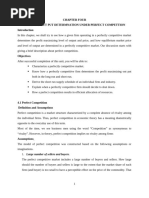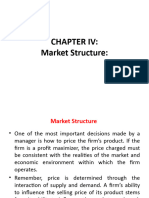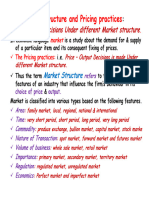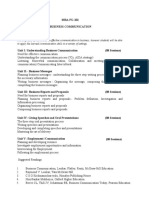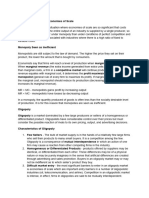Module 4 Part 6
Uploaded by
Sabir AliModule 4 Part 6
Uploaded by
Sabir AliModule 4: Part 6
Perfectly Competitive Markets
Main Points:
We have just finished looking at the cost side of the profit maximization problem.
We now want to refocus our attention on the demand and revenue side.
TR = P*Q, and the relationship between price and quantity sold is called our
demand curve. Thus, understanding this relationship (demand), is essential
towards our understanding of revenue.
The key variable that best summarizes this relationship is elasticity: the slope of
demand in percentage terms: it tells us how sales change (in %) when we change
price by 1%.
So the essential question becomes “what influences the shape of an individual
firm’s demand curve?”
A key to this answer is the structure of the market that the firm operates in.
There are two extreme forms of market structure: at one end is perfect
competition: in this case firms face perfectly elastic demand curve (graphically
they are horizontal). At the other extreme is monopoly where the demand curve
for the firm is, by definition, the market demand curve (which is downward
sloping)
With a flat demand curve the firm has no ability to influence price – they have to
take it as given. We say that perfectly competitive firms have NO market power.
Monopolists on the other hand DO have market power: they can reduce output in
order to raise their price.
A key condition for allocative and productive efficiency is that markets must be
perfectly competitive: if they are not then these socially desirable properties will
not hold.
The Most important technical points are:
PC firms have a perfectly elastic demand curve
A flat demand curve implies that P = MR
Since profit max. is where MR = MC, and for PC we have P = MR
then… FOR PC FIRMS P = MC
P = MC FOR PC FIRMS (I REPEAT!!!)
In the short run PC firms are allocatively efficient because P =
MC
In the long run, because of costless entry and exit, economic
profits for a PC firm are 0, and these firms are productively
efficient (because they produce at the minimum of ATC)
What are the characteristics of a perfectly competitive market?
The term “market structure” refers to the set of specific properties that a market has
which will influence the decisions made by firms in that industry.
Essentially, we are moving from the generic problem of “how does any old firm decide
how much to produce?” to “how does a firm in a market characterized in this specific
way decide how much to produce?”
That is, we are introducing characteristics of the market into the decision making process
of a firm.
Let’s first look at the general set of features we will examine:
Number and size of firms in the industry
Information structure of industry
Degree of substitutability of different producers products
Ease of entry and exit
So all markets in the real world vary in terms of these properties, here are some
examples:
1. Cereal market:
a. A few large firms dominate the market
b. Pretty close to perfect information for buyers and sellers
c. There is product differentiation: they do NOT produce perfect substitutes
d. Entry and exit are likely to be costly
2. Flyer service for woodlake/brandermill
a. Fairly large number of small firms
b. Perfect information
c. Perfect substitutes
d. Very low entry and exit costs
3. market for doctors
a. large number of small firms
b. consumers have very imperfect information regarding quality
c. doctors are not identical
d. entry costs are fairly high, exit costs also.
In these notes we will examine a very specific type of market: perfectly competitive
markets:
Characteristics of a perfectly competitive market:
1. large numbers of small buyers and sellers
2. perfect information
3. perfect substitutes
4. costless entry and exit
So our question is “how do firms make output decisions under these market conditions?”
You might also like
- Chapter 35 - Different Market StructuresNo ratings yetChapter 35 - Different Market Structures52 pages
- Consulting Interview Case Preparation: Frameworks and Practice CasesFrom EverandConsulting Interview Case Preparation: Frameworks and Practice CasesNo ratings yet
- Perfect Competition: Ch. 20, Economics 9 Ed, R.A. ArnoldNo ratings yetPerfect Competition: Ch. 20, Economics 9 Ed, R.A. Arnold11 pages
- Perfect Competition, Monopoly, Monopolistic Competition, Oligopoly and Barrier To EntryNo ratings yetPerfect Competition, Monopoly, Monopolistic Competition, Oligopoly and Barrier To Entry18 pages
- Production, Costs, and Market Supply in Competitive Markets - Part BNo ratings yetProduction, Costs, and Market Supply in Competitive Markets - Part B43 pages
- Register Free: Syllabus Revision 20% Guaranteed Score Doubt Solving NasaNo ratings yetRegister Free: Syllabus Revision 20% Guaranteed Score Doubt Solving Nasa13 pages
- Principles of Economics CH 5 Profit Maximization of A CompetitiveNo ratings yetPrinciples of Economics CH 5 Profit Maximization of A Competitive31 pages
- Output Decision of A Firm in Perfectly Competitive MarketNo ratings yetOutput Decision of A Firm in Perfectly Competitive Market13 pages
- Microeconomics - Tutorial Practice Attempt 10No ratings yetMicroeconomics - Tutorial Practice Attempt 103 pages
- Lecture 16 Market Structures-Perfect CompetitionNo ratings yetLecture 16 Market Structures-Perfect Competition41 pages
- The Market Makers (Review and Analysis of Spluber's Book)From EverandThe Market Makers (Review and Analysis of Spluber's Book)No ratings yet
- Application Form of Consular Legalization of The Embassy/Consulate of The People's Republic of ChinaNo ratings yetApplication Form of Consular Legalization of The Embassy/Consulate of The People's Republic of China3 pages
- The Efffect of Market Segmentaion On InvetsorNo ratings yetThe Efffect of Market Segmentaion On Invetsor34 pages
- The Evolution of The Internet From Military Experiment To General Purpose TechnologyNo ratings yetThe Evolution of The Internet From Military Experiment To General Purpose Technology25 pages
- Electronic Commerce Customer Relationship ManagemeNo ratings yetElectronic Commerce Customer Relationship Manageme27 pages
- A Study of Use and Impact of Market Segmentation PNo ratings yetA Study of Use and Impact of Market Segmentation P11 pages
- Branding Knowledge Brand Building Beyond Product ANo ratings yetBranding Knowledge Brand Building Beyond Product A19 pages
- Logistics at Large Jumping The Barriers of The LogNo ratings yetLogistics at Large Jumping The Barriers of The Log22 pages
- IEGR 351 Chapter 10: Inferences Concerning Proportions: Sections 10.1-10.3No ratings yetIEGR 351 Chapter 10: Inferences Concerning Proportions: Sections 10.1-10.315 pages
- Probability and Statistics II Syllabus Spring 2022 - StudentNo ratings yetProbability and Statistics II Syllabus Spring 2022 - Student7 pages
- The Digital Economy Is An Umbrella Term Used To Describe Markets That Focus On Digital TechnologiesNo ratings yetThe Digital Economy Is An Umbrella Term Used To Describe Markets That Focus On Digital Technologies12 pages
- Agricultural Product Prices Fifth Edition William G. Tomek - The ebook with all chapters is available with just one click100% (3)Agricultural Product Prices Fifth Edition William G. Tomek - The ebook with all chapters is available with just one click47 pages
- CAIE O Level Firms, Cost, Revenue & Objectives PDF100% (1)CAIE O Level Firms, Cost, Revenue & Objectives PDF28 pages
- Accounting For Public Enterprises in Ethiopia75% (8)Accounting For Public Enterprises in Ethiopia13 pages
- Amity BBA 1 ST Sem Assignment ME NEW (3) ASODLNo ratings yetAmity BBA 1 ST Sem Assignment ME NEW (3) ASODL9 pages
- Microeconomics 5th Edition N. Mankiw - Own the complete ebook set now in PDF and DOCX formats100% (3)Microeconomics 5th Edition N. Mankiw - Own the complete ebook set now in PDF and DOCX formats76 pages
- Mec-108: Economics of Social Sector and Environment: Assignment (TMA)No ratings yetMec-108: Economics of Social Sector and Environment: Assignment (TMA)10 pages
- AP Microeconomics Market Failure Deadweight Loss Curriculum ModuleNo ratings yetAP Microeconomics Market Failure Deadweight Loss Curriculum Module54 pages
- Capturing Surplus: Solutions To Review Questions100% (1)Capturing Surplus: Solutions To Review Questions23 pages
- Mid term exam 1 2024 - Xem lại lần làm thửNo ratings yetMid term exam 1 2024 - Xem lại lần làm thử1 page
- Data Monopolists Like Google Are Threatening The Economy-1No ratings yetData Monopolists Like Google Are Threatening The Economy-14 pages
- The Political Economy of Corruption: A Philippine IllustrationNo ratings yetThe Political Economy of Corruption: A Philippine Illustration20 pages
- (Ebook) Intermediate microeconomics: a modern approach by Varian, Hal R ISBN 9780393934243, 9780393935332, 0393934241, 0393935337 - Download the ebook now to start reading without waitingNo ratings yet(Ebook) Intermediate microeconomics: a modern approach by Varian, Hal R ISBN 9780393934243, 9780393935332, 0393934241, 0393935337 - Download the ebook now to start reading without waiting48 pages









